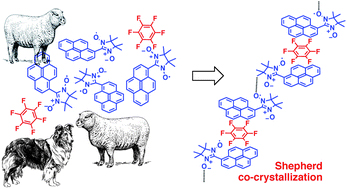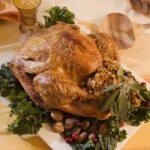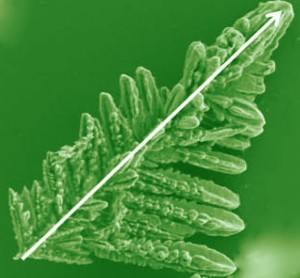Here is this week’s selection of advanced articles of interest to crystal engineers from across the RSC journals
Fluorene-based Cu(II)-MOF: a visual colorimetric anion sensor and separator based on an anion-exchange approach
Jian-Ping Ma, Yang Yu and Yu-Bin Dong
Chem. Commun., 2012, Advance Article
DOI: 10.1039/C2CC16800F, Communication
Six-rayed star-like nanostructures in prospective plasmonic devices
Takumi Miyamoto, Shiomi Saito, Toshihiro Isobe, Akira Nakajima and Sachiko Matsushita
Chem. Commun., 2012, Advance Article
DOI: 10.1039/C2CC16353E, Communication
Bucky-blocks: templating a coordination network with C60
Edwin C. Constable, Guoqi Zhang, Catherine E. Housecroft and Jennifer A. Zampese
CrystEngComm, 2012, Advance Article
DOI: 10.1039/C2CE06156B, Paper
Crystal engineering of multiple-component organic solids: Pharmaceutical cocrystals of tadalafil with persistent hydrogen bonding motifs
David R. Weyna, Miranda L. Cheney, Ning Shan, Mazen Hanna, Łukasz Wojtas and Michael J. Zaworotko
CrystEngComm, 2012, Advance Article
DOI: 10.1039/C2CE06574F, Communication
Discovery, development, and functionalization of Zr(IV)-based metal–organic frameworks
Min Kim and Seth M. Cohen
CrystEngComm, 2012, Advance Article
DOI: 10.1039/C2CE06491J, Highlight
Step kinetics on monosodium urate monohydrate single crystal surfaces: an in situ AFM study
Clare M. Perrin and Jennifer A. Swift
CrystEngComm, 2012, Advance Article
DOI: 10.1039/C2CE05985A, Paper
New photoluminescence acylhydrazidate-coordinated complexes
Juan Jin, Fu-Quan Bai, Ming-Jun Jia, Yu Peng, Jie-Hui Yu and Ji-Qing Xu
Dalton Trans., 2012, Advance Article
DOI: 10.1039/C1DT11846C, Paper
Zinc and cadmium 2-pyrazinephosphonates: Syntheses, structures and luminescent properties
Yun-Sheng Ma, Xiao-Yan Tang, Wen-Yu Yin, Bin Wu, Feng-Feng Xue, Rong-Xin Yuan and Soumyajit Roy
Dalton Trans., 2012, Advance Article
DOI: 10.1039/C1DT11250C, Paper
Crystal structure of novel compounds in the systems Zr–Cu–Al, Mo–Pd–Al and partial phase equilibria in the Mo–Pd–Al system
Atta U. Khan, P. Rogl and G. Giester
Dalton Trans., 2012, Advance Article
DOI: 10.1039/C1DT11972A, Paper
Plastic crystal phases with high proton conductivity
Usman Ali Rana, R. Vijayaraghavan, Douglas R. MacFarlane and Maria Forsyth
J. Mater. Chem., 2012, Advance Article
DOI: 10.1039/C2JM15288F, Paper
Change in the magnetostructural properties of rare earth doped cobalt ferrites relative to the magnetic anisotropy
S. R. Naik and A. V. Salker
J. Mater. Chem., 2012, Advance Article
DOI: 10.1039/C2JM15228B, Paper
Synthesis and characterisation of vanadium doped alkaline earth lanthanum germanate oxyapatite electrolyte
Henan Li, Tom Baikie, Stevin S. Pramana, J. Felix Shin, Peter R. Slater, Frank Brink, James Hester, Kia Wallwork and Tim J. White
J. Mater. Chem., 2012, Advance Article
DOI: 10.1039/C1JM13752B, Paper
A new congruent-melting oxyborate, Pb4O(BO3)2 with optimally aligned BO3 triangles adopting layered-type arrangement
Hongwei Yu, Shilie Pan, Hongping Wu, Wenwu Zhao, Fangfang Zhang, Hongyi Li and Zhihua Yang
J. Mater. Chem., 2012, Advance Article
DOI: 10.1039/C1JM14590H, Paper
Piezofluorochromism and morphology of a new aggregation-induced emission compound derived from tetraphenylethylene and carbazole
Xie Zhou, Haiyin Li, Zhenguo Chi, Xiqi Zhang, Jianyong Zhang, Bingjia Xu, Yi Zhang, Siwei Liu and Jiarui Xu
New J. Chem., 2012, Advance Article
DOI: 10.1039/C1NJ20782B, Paper
New-phase VO2 micro/nanostructures: investigation of phase transformation and magnetic property
Liang Liu, Feng Cao, Tao Yao, Yang Xu, Min Zhou, Bingyan Qu, Bicai Pan, Changzheng Wu, Shiqiang Wei and Yi Xie
New J. Chem., 2012, Advance Article
DOI: 10.1039/C1NJ20798A, Paper
Growth and branching of gold nanoparticles through mesoporous silica thin films
Paula C. Angelomé, Isabel Pastoriza-Santos, Jorge Pérez-Juste, Benito Rodríguez-González, Andrés Zelcer, Galo J. A. A. Soler-Illia and Luis M. Liz-Marzán
Nanoscale, 2012, Advance Article
DOI: 10.1039/C2NR11547F, Paper
Synthesis of bimetallic Pt-Pd core-shell nanocrystals and their high electrocatalytic activity modulated by Pd shell thickness
Yujing Li, Zhi Wei Wang, Chin-Yi Chiu, Lingyan Ruan, Wenbing Yang, Yang Yang, Richard E. Palmer and Yu Huang
Nanoscale, 2012, Advance Article
DOI: 10.1039/C1NR11374G, Paper
Polyoxometalate-based crystalline tubular microreactor: redox-active inorganic–organic hybrid materials producing gold nanoparticles and catalytic properties
Dong-Ying Du, Jun-Sheng Qin, Ting-Ting Wang, Shun-Li Li, Zhong-Min Su, Kui-Zhan Shao, Ya-Qian Lan, Xin-Long Wang and En-Bo Wang
Chem. Sci., 2012, Advance Article
DOI: 10.1039/C2SC00586G, Edge Article
Changing and challenging times for service crystallography
Simon J. Coles and Philip A. Gale
Chem. Sci., 2012, Advance Article
DOI: 10.1039/C2SC00955B, Minireview
RbFe2+Fe3+F6: Synthesis, structure, and characterization of a new charge-ordered magnetically frustrated pyrochlore-related mixed-metal fluoride
Sun Woo Kim, Sang-Hwan Kim, P. Shiv Halasyamani, Mark A. Green, Kanwal Preet Bhatti, C. Leighton, Hena Das and Craig J. Fennie
Chem. Sci., 2012, Advance Article
DOI: 10.1039/C2SC00765G, Edge Article
 The CrystEngComm team wishes you success in the Year of the Dragon, and we hope that you enjoy your New Year holiday.
The CrystEngComm team wishes you success in the Year of the Dragon, and we hope that you enjoy your New Year holiday.











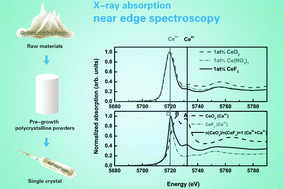
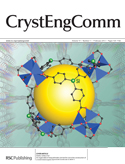

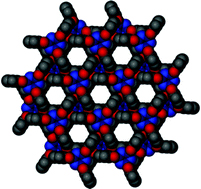
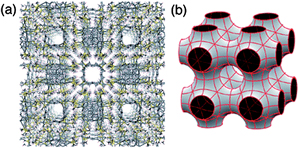

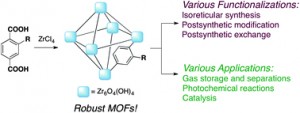 This comprehensive Highlight by Min Kim and Seth Cohen outlines the discovery, development and functionalization of Zr(IV)-based metal–organic frameworks. MOFs in general have been widely studied and the potential in biotechnological applications, catalysis, chemical sensing, gas separation and gas storage is of great interest.
This comprehensive Highlight by Min Kim and Seth Cohen outlines the discovery, development and functionalization of Zr(IV)-based metal–organic frameworks. MOFs in general have been widely studied and the potential in biotechnological applications, catalysis, chemical sensing, gas separation and gas storage is of great interest.
